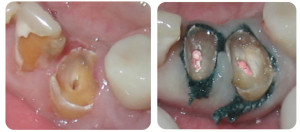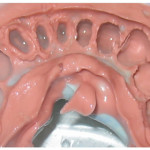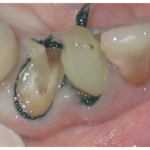The idea here was to attempt to restore these teeth without extensive periodontal surgery. Saving natural teeth is a better option than extractions with subsequent implant therapy. Proper utilization of implants is fine when conservative therapy is not possible. The radiograph shows restorable roots.
 Though anesthesia was probably not necessary because these teeth appeared non-vital, I did administer local anesthesia (topical plus septicaine). The patient appreciated this and it insured that the procedures would be pain free. Excavation of decay revealed restorable roots. Endodontic therapy was performed and gingival retraction cord was placed to isolate the field prior to placement of carbon fiber posts and cores.
Though anesthesia was probably not necessary because these teeth appeared non-vital, I did administer local anesthesia (topical plus septicaine). The patient appreciated this and it insured that the procedures would be pain free. Excavation of decay revealed restorable roots. Endodontic therapy was performed and gingival retraction cord was placed to isolate the field prior to placement of carbon fiber posts and cores.
Placement of carbon fiber posts and cores followed by fabrication of temporary crowns.
 This is the impression that we took of three of the teeth on one side. At two appointments prior to taking this impression we removed all the temporary crowns, did final preparations and relined the temporary crowns. This is a time consuming but important step. Breaking up a complex case into shorter appointments is better for the patient and the dentist. Of course, when working with very small teeth it is important to utilize high powered magnification (6.00 magnification by Designs for Vision 1.800.345.4009). Even with a good impression we had to remake one crown due to an open margin. Leaving an open margin could result in cement wash out and recurrent decay. Striving for perfection is the hallmark of “First Class Dental Care” ( Amazon ).
This is the impression that we took of three of the teeth on one side. At two appointments prior to taking this impression we removed all the temporary crowns, did final preparations and relined the temporary crowns. This is a time consuming but important step. Breaking up a complex case into shorter appointments is better for the patient and the dentist. Of course, when working with very small teeth it is important to utilize high powered magnification (6.00 magnification by Designs for Vision 1.800.345.4009). Even with a good impression we had to remake one crown due to an open margin. Leaving an open margin could result in cement wash out and recurrent decay. Striving for perfection is the hallmark of “First Class Dental Care” ( Amazon ).
The final crowns. After discussing this case with a very experienced laboratory technician it was agreed to use a stronger metal coping to avoid distortion when baking on the porcelain. The final restorations are a big improvement. The aesthetics could have been better ( more characterization ) but this patient doesn’t show her lower teeth.
 The results are good and the patient did avoid extractions and implant surgery. We did perform some miner electrosurgical resections and though I was concerned about infringement on the biological width I doubt that this will be a problem.
The results are good and the patient did avoid extractions and implant surgery. We did perform some miner electrosurgical resections and though I was concerned about infringement on the biological width I doubt that this will be a problem.
It is important that when preparing these teeth for crowns do not depend on the post/cores for total retention. The preparation must go slightly on to root structure. This is called the ferrule principle.
As we proceed further on this case we will replace her defective posterior bridges and restore a more natural curve of spee.



